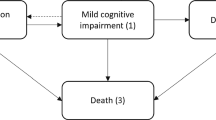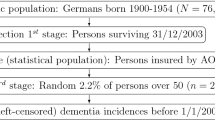Abstract
In prevalent cohort studies with follow-up, if disease duration is the focus, the date of onset must be obtained retrospectively. For some diseases, such as Alzheimer’s disease, the very notion of a date of onset is unclear, and it can be assumed that the reported date of onset acts only as a proxy for the unknown true date of onset. When adjusting for onset dates reported with error, the features of left-truncation and potential right-censoring of the failure times must be modeled appropriately. Under the assumptions of a classical measurement error model for the onset times and an underlying parametric failure time model, we propose a maximum likelihood estimator for the failure time distribution parameters which requires only the observed backward recurrence times. Costly and time-consuming follow-up may therefore be avoided. We validate the maximum likelihood estimator on simulated datasets under varying parameter combinations and apply the proposed method to the Canadian Study of Health and Aging dataset.



Similar content being viewed by others
References
Addona V, Wolfson DB (2006) A formal test for the stationarity of the incidence rate using data from a prevalent cohort study with follow-up. Lifetime Data Anal 12(3):267–284
Addona V, Atherton J, Wolfson DB (2012) Testing the assumptions for the analysis of survival data arising from a prevalent cohort study with follow-up. Int J Biostat https://doi.org/10.1515/1557-4679.1419
Asgharian M, Wolfson DB, Zhang X (2006) Checking stationarity of the incidence rate using prevalent cohort survival data. Stat Med 25(10):1751–1767
Asgharian M, Wolfson C, Wolfson DB (2014) Analysis of biased survival data: the Canadian Study of Health and Aging and beyond. CRC Press, New York, chapter 12, pp 193–208
Blumenthal S (1967) Proportional sampling in life length studies. Technometrics 9(2):205–218
Canadian Study of Health and Aging Working Group (1994) Canadian study of health and aging: study methods and prevalence of dementia. Can Med Assoc J 150(6):899–913
Comte F, Samson A, Stirnemann J (2015) Hazard estimation for censored data contaminated with additive measurement error: application to length of pregnancy. Test 24:338–359
Comte F, Mabon G, Samson A (2017) Spline regression for hazard rate estimation when data are censored and measured with error. Stat Neerl 71(2):115–140
Cox DR (1969) Some sampling problems in technology. Wiley, New York, Chapter 25, pp 506–527
De Gruttola V, Lagakos SW (1989) Analysis of doubly-censored survival data, with applications to AIDS. Biometrics 45(1):1–11
Hendrie H (1997) Epidemiology of dementia and alzheimer’s disease. Am J Geriatr Psychiatry 6(2 Suppl 1):S3–18
Keiding N (2006) Event history analysis and the cross-section. Stat Med 25(14):2343–2364
Keiding N, Kvist K, Hartvig H, Tvede M, Juul S (2002) Estimating time to preganancy from current durations in a cross-sectional sample. Biostatistics 3(4):565–578
Keiding N, Fine JP, Hansen OH, Slama R (2011) Accelerated failure time regression for backward recurrence times and current durations. Stat Probab Lett 81:724–729
Keiding N, Hansen OH, Sørensen DN, Slama R (2012) The current duration approach to estimating time to pregnancy (with discussion). Scand J Stat 39:185–213
McLain AC, Sundaram R, Thoma M, Louis GMB (2014) Semiparametric modeling of grouped current duration data with preferential reporting. Stat Med 33(23):3961–72
McLain AC, Sundaram R, Thoma M, Louis GMB (2018) Cautionary note on ’Semiparametric modeling of grouped current duration data with preferential reporting’. arXiv:1801.00775 [stat.AP]
McVittie JH (2017) Analysis of left-truncated right-censored survival data with uncertainty of onset times. Master’s thesis, McGill University
Principal Investigators: Wolfson C, Wolfson DB, Co-investigators: Addona V, Atherton J, Best A, Karunananthan S, Postuma R, Wolfson J (2012–2015) Canadian institutes of health research program: advancing theoretical and methodological innovations in health research. Project Title: Accelerating the generation of results from longitudinal studies of aging
Rouah F, Wolfson C (2001) A recommended method for obtaining the age of onset of dementia from the CSHA database. Int Psychogeriatr 13(S1):57–70
Sun J (1995) Empirical estimation of a distribution function with truncated and doubly interval-censored data and its application to AIDS studies. Biometrics 51(3):1096–1104
Sun J, Woodroofe M (1996) Adaptive smoothing for a penalized npmle of a non-increasing density. J Stat Plan Inference 52(2):143–159
Turnbull BW (1976) The empirical distribution function with arbitrarily grouped, censored and truncated data. J R Stat Soc Ser B (Methodol) 38(3):290–295
Wolfson C, Wolfson DB, Asgharian M, M’Lan CE, Ostbye T, Rockwood K, Hogan DB (2001) A reevaluation of the duration of survival after the onset of dementia. N Engl J Med 344(15):1111–1116
Woodroofe M, Sun J (1993) A penalized maximum likelihood estimator of \(f(0+)\) when \(f\) is non-increasing. Stat Sin 3:501–515
Yamaguchi K (2003) Accelerated failure-time mover-stayer regression models for the analysis of last episode data. Sociol Methodol 33:81–110
Zhong Y, Cook RJ (2014) Measurement error for age of onset in prevalent cohort studies. Appl Math 5(11):1672–1683
Acknowledgements
The CSHA was supported by the Seniors Independence Research Program, through the National Health Research and Development Program (NHRDP) of Health Canada (Project 6606-3954-MC[S]). The progression of dementia project within the CSHA was supported by Pfizer Canada through the Health Activity Program of the Medical Research Council of Canada and the Pharmaceutical Manufacturers Association of Canada; by the NHRDP (Project 6603-1417-302[R]); by Bayer; and by the British Columbia Health Research Foundation (Projects 38 [93-2] and 34 [96-1]). We thank the reviewers and editorial board for their suggestions, which we believe, led to an improved manuscript. Funding was provided by Natural Sciences and Engineering Research Council of Canada (Grant Nos. PGSD3 (J.H. McVittie), Discovery Grant (D.A. Stephens).
Author information
Authors and Affiliations
Corresponding author
Additional information
Publisher's Note
Springer Nature remains neutral with regard to jurisdictional claims in published maps and institutional affiliations.
Appendix
Appendix
We derive the likelihood given in (3) by calculating the approximate observation specific probability contributions. Let \(\varDelta t_i\) denote an arbitrarily small positive number. Then,
which, through the assumption that \(T_i^{\text {obs}}\) is independent of \(X_i\) conditional on \(T_i^{\text {brt}}\), for all i,
Dividing by \(\varDelta t_i\) and letting \(\varDelta t_i\) tend to zero, under the assumption of a stationary onset process, the equation above corresponds to the i-th term given in (3).
Rights and permissions
About this article
Cite this article
McVittie, J.H., Wolfson, D.B. & Stephens, D.A. Parametric modelling of prevalent cohort data with uncertainty in the measurement of the initial onset date. Lifetime Data Anal 26, 389–401 (2020). https://doi.org/10.1007/s10985-019-09481-1
Received:
Accepted:
Published:
Issue Date:
DOI: https://doi.org/10.1007/s10985-019-09481-1




